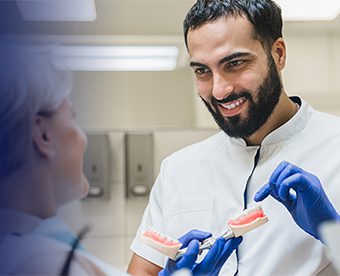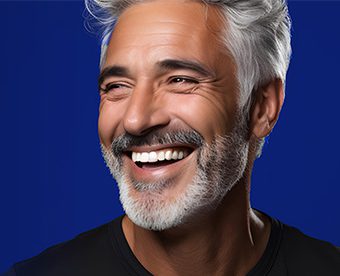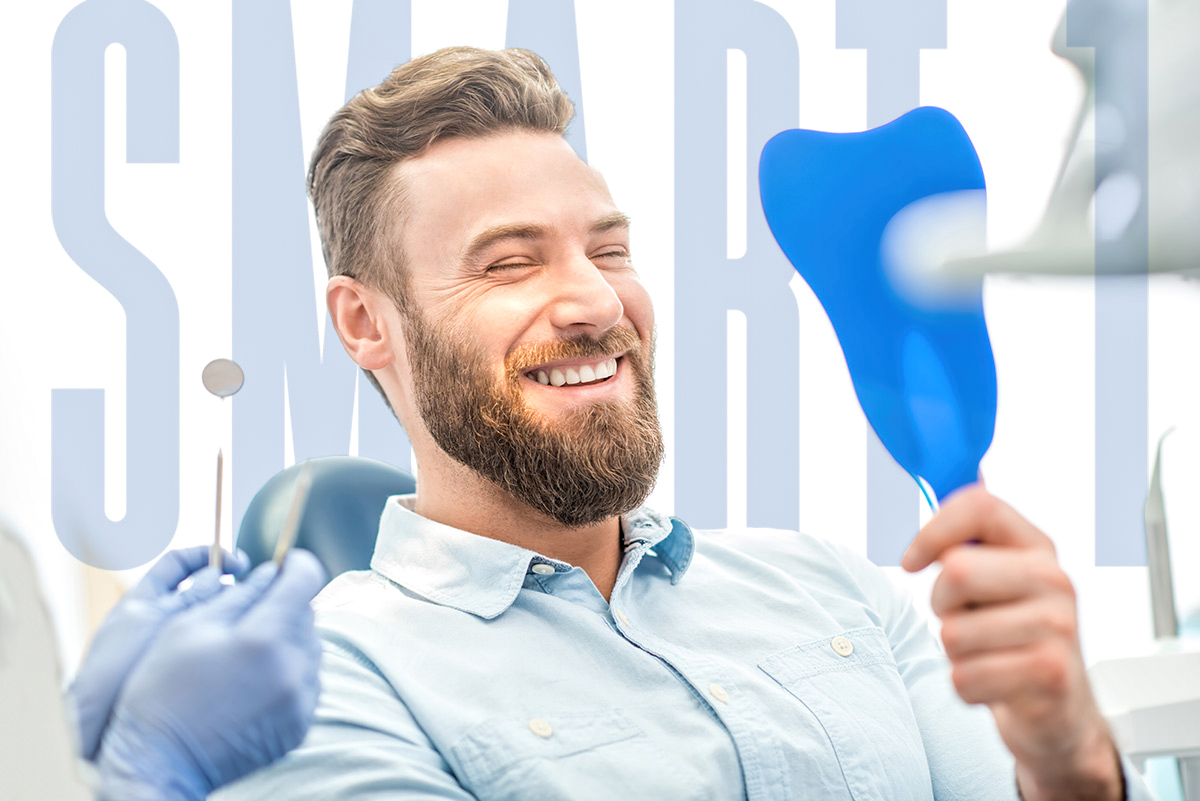Evaluation
There are many critical elements to evaluate when preparing to restore an edentulous patient with an implant-supported prosthesis.
Following are three of the conditions that may affect the choice of restoration.
What is needed to support facial esthetics and lip support?
If the patient has lost a significant amount of bone, will that require a denture flange to provide support for the lip and facial esthetics?
What is the available vertical clearance?
One of the most important evaluations to make is the vertical clearance that is available.
Where is the smile line relative to the display of natural tissue within the smile?
Evaluation of the smile line is equally as important to consider.
The Importance of the Diagnostic Work-up
Burbank Dental Lab works with dozens of edentulous cases every week. Occasionally there are cases that start out with a pre-defined specific prosthetic appliance decided in concrete by the patient before the first impression is taken. This can present a challenge if the patient’s expectations are directed towards a result that is different from that which is possible in reality. This can cause stress all the way around.
I once attended a program lecture by Dr. Jimmy Eubanks where he put forward the idea that it is better to promote the diagnostic package than to go right to the “selling” of the treatment. If you promote a diagnostic package that is priced appropriately it will develop ownership and dedication to treatment within the patient. Properly used and measured, the diagnostic components will show you in advance what your realistic options are for the final prosthesis.
It is extremely important to educate and involve your patients in the ownership of their condition or “disease” before you work up a treatment plan for that condition.
Many times patients get in the driver's seat of clinical decisions, demanding an All-On-4®, teeth in a day, or screw-retained prosthesis when what they need is a bar support removable denture.
The diagnostic package including bite blocks, wax set-ups, and photo series, can assist you in directing your patients to what is going to deliver the best results for them as an individual, and what is possible given the conditions in the mouth.
First, let’s discuss the importance of evaluating vertical and buccal/lingual requirements for each type of prosthetic appliance, and whether the intended dental restoration will be fixed or an implant-supported denture. It is critical to begin the evaluation process prior to the surgical appointment for the implants as this will assist in the planning of the surgical goals.
For the purpose of this article, we will discuss only the importance of the use of bite blocks and wax set-ups. Of course x-rays, CBCT, and photos are all going to be important aspects of the pre-treatment plan evaluation
Bite Blocks
Start with bite block(s), making sure that each arch bite block is the thickness required of the desired prostheses, plus 1.5 mm thickness per arch. If you are not planning on opening vertical, you can also use an existing denture or a duplicate of that denture, but always do a reline impression. You must be prepared to consider opening vertical as it may be necessary for some prosthetics. Use the chart below to request a bite block that is the approximate dimensions of the prosthetic goal.
For example, if you are aiming at a monolithic zirconia hybrid, the bite block needs to have occlusal thickness of at least 8 mm, buccal/lingual width of 10 mm, and a minimum wall thickness from the proposed screw hole of 3 mm buccal and lingual. Refer to the “Implant Prosthetic Dimensional Requirement Chart” below.
Implant Prosthetic Dimensional Requirement Chart
Occ. Clearance Tissue to Opposing
Buccal/Lingual Width
Wall Thickness from screw hole
PFM Hybrid
Zirconia Hybrids
Smart Composite Hybrid
Conventional Hybrid
Denture over Hader Bar
Denture over Locator Bar
Denture w/Locator Direct to Implants
7 MM
8 MM
10 MM
11 MM
11 MM
12 MM
10 MM
8 MM
10 MM
9 MM
9 MM
11 MM
11 MM
10 MM
2.5 MM
3 MM
3 MM
3 MM
4 MM
4 MM
3 MM
Wax-Up Try-In With Teeth
If you are considering that the final treatment may be a screw-retained hybrid type of restoration then consider what effect the flange of the denture set-up has on the lips. Is the flange of the denture adding necessary lip support that would be lost if a screw-retained restoration was the goal? You can test this by trying in the set-up with a flange of normal thickness, take photos and measure the thickness of the flange. Next cut the facial part of the flange off and take another photo. This will show you if a flange is necessary for facial esthetics.
At this point, you should evaluate lip support and where the tissue display is within the smile. If the transition from the restoration to natural tissue is within the smile line, then this would contra-indicate a screw-retained hybrid. This simple test will tell you more or less if the case will be screw-retained or a denture over a bar.
Measure the Thickness of the Wax Set-Up
Take measurements of the wax set-up from several perspectives. You will want to know the thickness in the approximate position of where you would like to place the implants. Measure a couple of posterior positions on the right and left, and at least two in the anterior quadrant as well. Also, measure the thickness from the center of the ridge to the buccal and lingual surfaces of the wax set-up. (This assumes that the implants will be placed in the center of the ridge.) Refer to the “Implant Prosthetic Dimensional Requirement Chart” for appropriate measurements.
NOTE: Be aware that if the draw of the final implant placement requires the use of multi-abutments, then you will lose 3 mm in your final thickness around the abutments.
In Summary
If you focus on these simple pre-treatment plan diagnostic tools, you can increase the predictability and profitability of your implant-supported edentulous cases. This will give you peace of mind as you build your implant-related practice.
Burbank Dental Lab can be your superpower in creating successful outcomes for your implant restorations. We offer free evaluation and pre-treatment consults for all of your cases. Complete the form below or call us today to discuss an upcoming dental implant restoration case.











